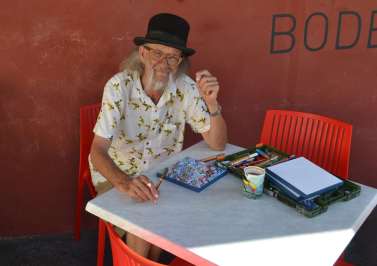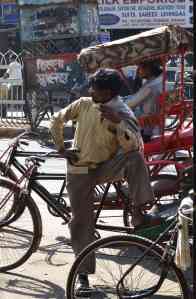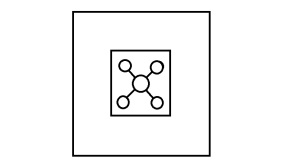This blog has reached its fifth draft, partly because I have hesitated over putting too much profundity into what is, essentially, a travelogue. But without wishing to follow Socrates all the way, I really ought to worry a little less about losing my audience.
A few years back, the in-word in business was “networking”. Of course, they borrowed the term from internet circles, who probably got it from somewhere else, like the telephone. But as I blog about this walkabout, I am starting to see that networks are really everywhere – indeed, it seems to me that life and existence are much more to do with networks and cooperation than to do with individuals. This is where my Buddhist friends will probably be saying, “At last, he gets it”, but I’ll get to them in a minute.
A while back, when I was in West Bengal a biologist I was talking to (who is also a Buddhist, as it happens) remarked on how Darwin was only very narrowly right. Yes, she said, competition may determine which particular plant survives in a particular circumstance, but it is cooperation that shapes ecology and therefore evolution. From the complex interactions of predators and prey in the Serengeti, to the way in which our whole metabolism depends on bacteria with which we have no conscious connection, the evidence for the interdependency of life is overwhelming. My brains work – indeed live – by the formation of ever developing networks, whole cascades of which have to cooperate in order to get a fork-full of food into my mouth. And so we can see that it is the whole environment and the networks within it that evolve, not just the individual species.

Itinerant painter and philosopher Horatio
And these networks, of course, stretch into our more immediate realities. Families, clubs and nations, professions, religious congregations and high wire trapeze acts all form networks which, in their interactions, form larger and more intricate relationships across time and space. Take, for example, my meeting with Horatio, the painter. A less likely pairing, you would work hard to find – me, the semi-retired business man, with his camera and laptop – him, the itinerant who travels and lives on the strength of abstract pictures that he draws with acrylic pens. My questions about his art and his about my accent, lead to a conversation that stretches from Paris to Wellington and from Martin Luther King to Henry David Thoreau, while we sit in the shade of a café awning in Fremantle. As we talk, we explore our common and different networks and it is thus that most relationships are formed and strengthened. Do we not say of someone we find of no interest, “We have nothing in common”?
But here’s another question; what is it that sustains the network? Well, clearly there is huge variance, but it seems to me that the most fundamental features are energy and incompleteness, after which come value and then inertia. Energy only flows and therefore, associations and networks only form when things are incomplete or hungry (be it for energy, social interaction, influence, recognition). When a person declares that they ”love” Paris, or they “hate” New York in winter, are they not conveying to us their values and therefore their networks; inviting us to join with both?[1]
But, if our lives are really about the ebb and flow of networked values and energies, what then is the value of our sense of individual self? My Buddhist friends might have us believe that our sense of self is effectively an illusion; existing only by associations that will die as soon as our brains do or as we free ourselves from demeaning attachments. But surely, for any network to exist, it must have nodes by which it is bound and forms by which it is channeled. Yes, they may evolve, develop or diminish, but we all have that experience in life, of changing yet, in some fundamental sense, continuing. And if networks are really the whole, why should we seek to detach from them? Surely the passions of the great “yes” or the great “no”; the great love or the great defiance, the great comprehension; those great moments of spiritual incandescence – these both announce and make a powerful something, a permanence of value and belief, distilled from our very being and the networks that we are part of, that can extend beyond death, making us permanent carriers of those very values that we cherish and the networks of which we are part. And so, in some sense, is part of the meaning of this life, to forge the values, the beliefs and the networks that we will carry into the next?
[1] Curiously, I think this suggests that in some profound sense, we humans are the most incomplete of all. Do we not form the widest and most varied networks, not just between our kind, but with animals, plants, localities, that we add to, incessantly, as we travel from place to place?









